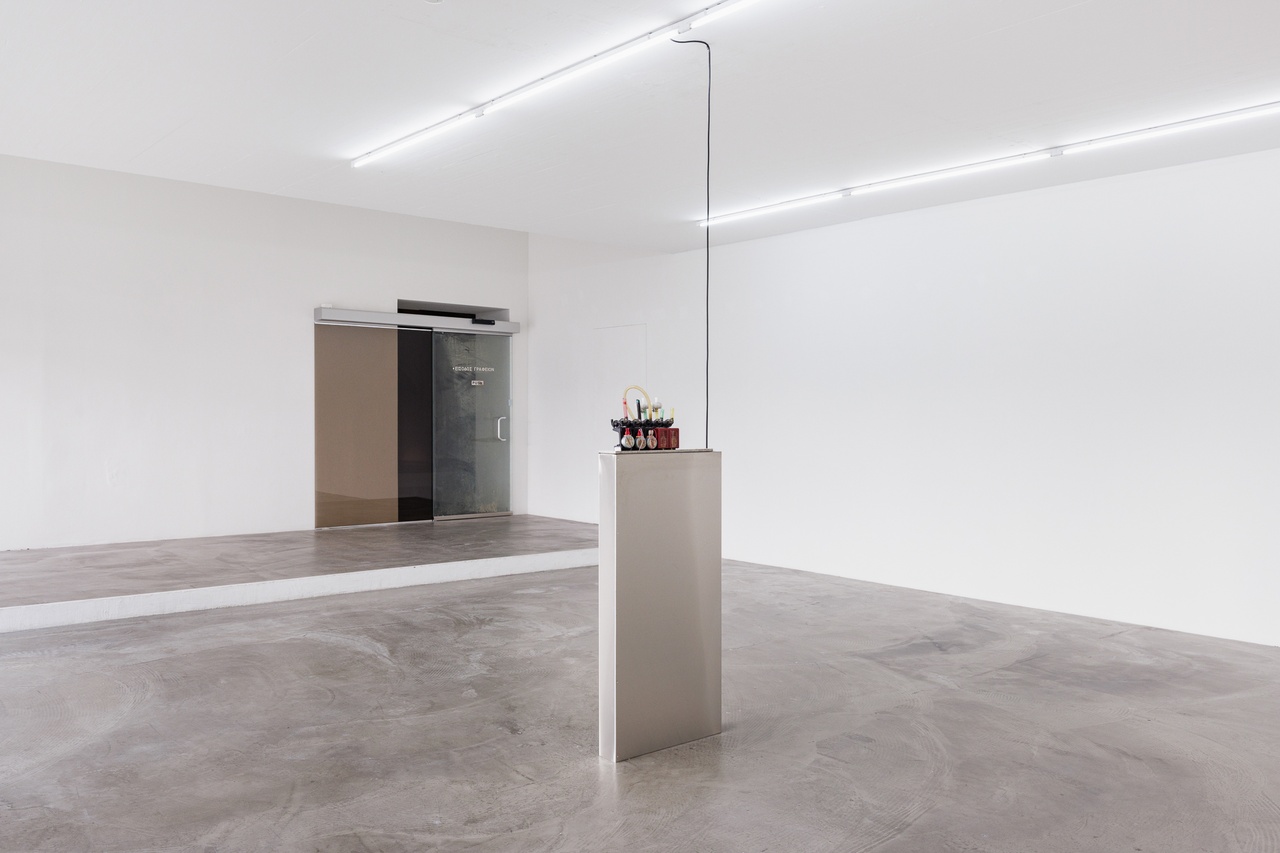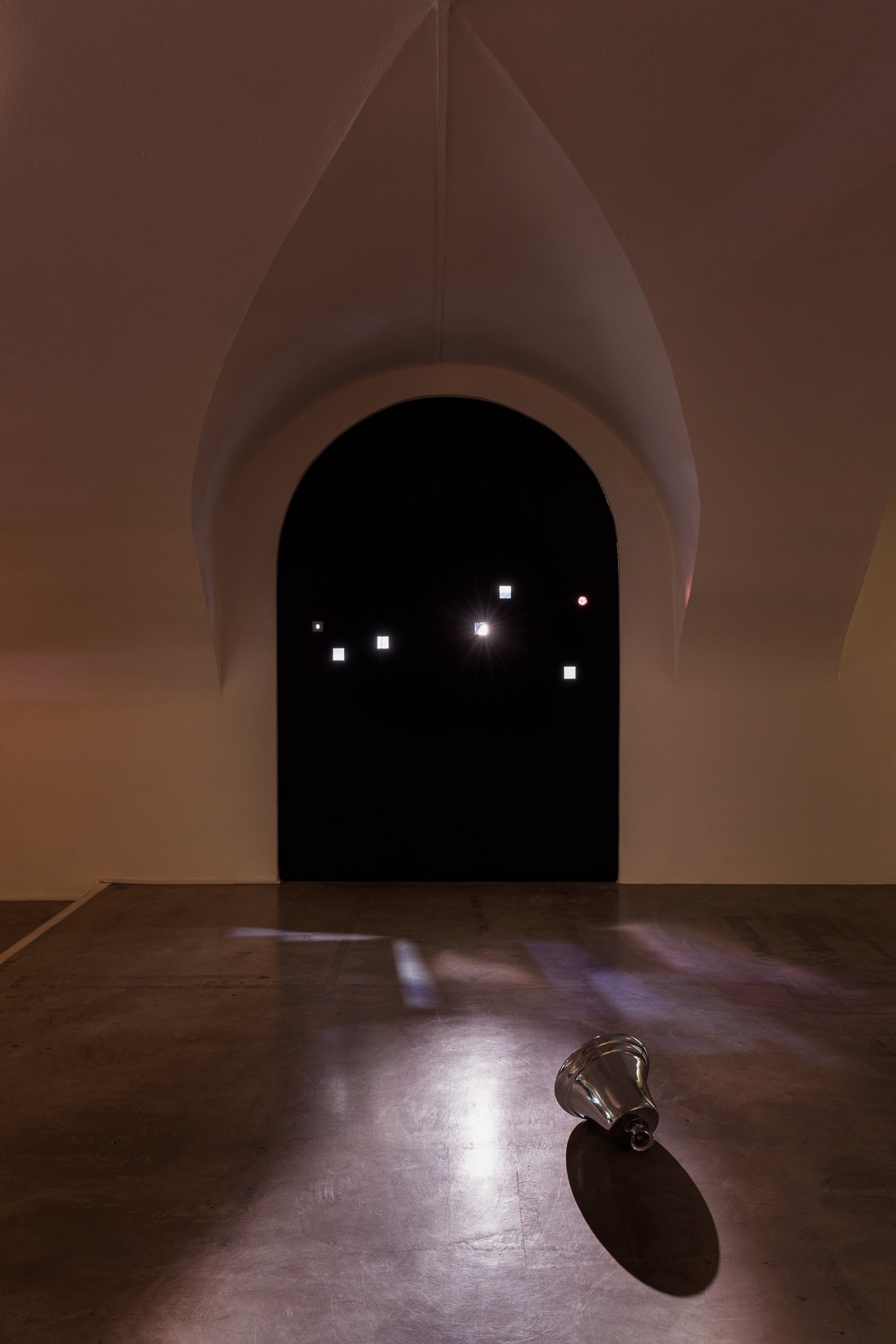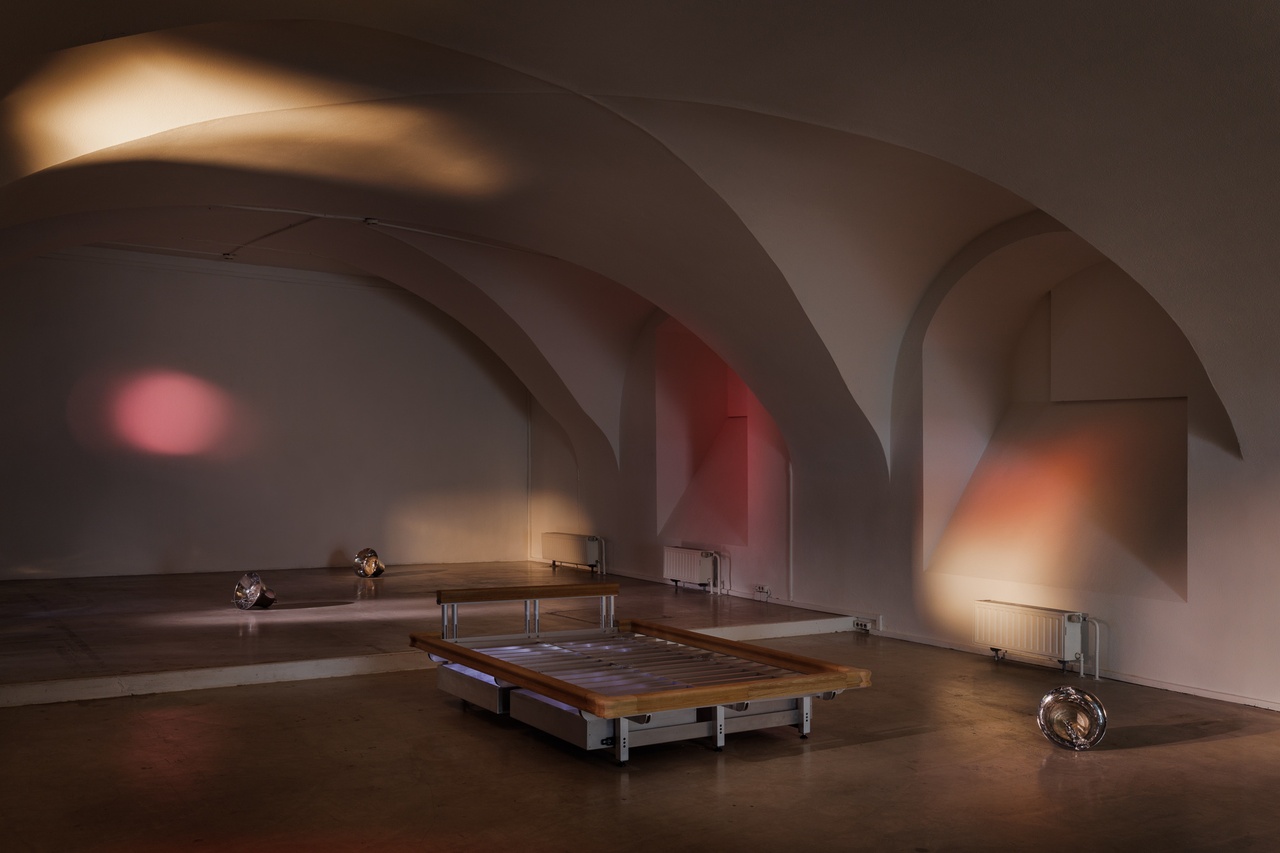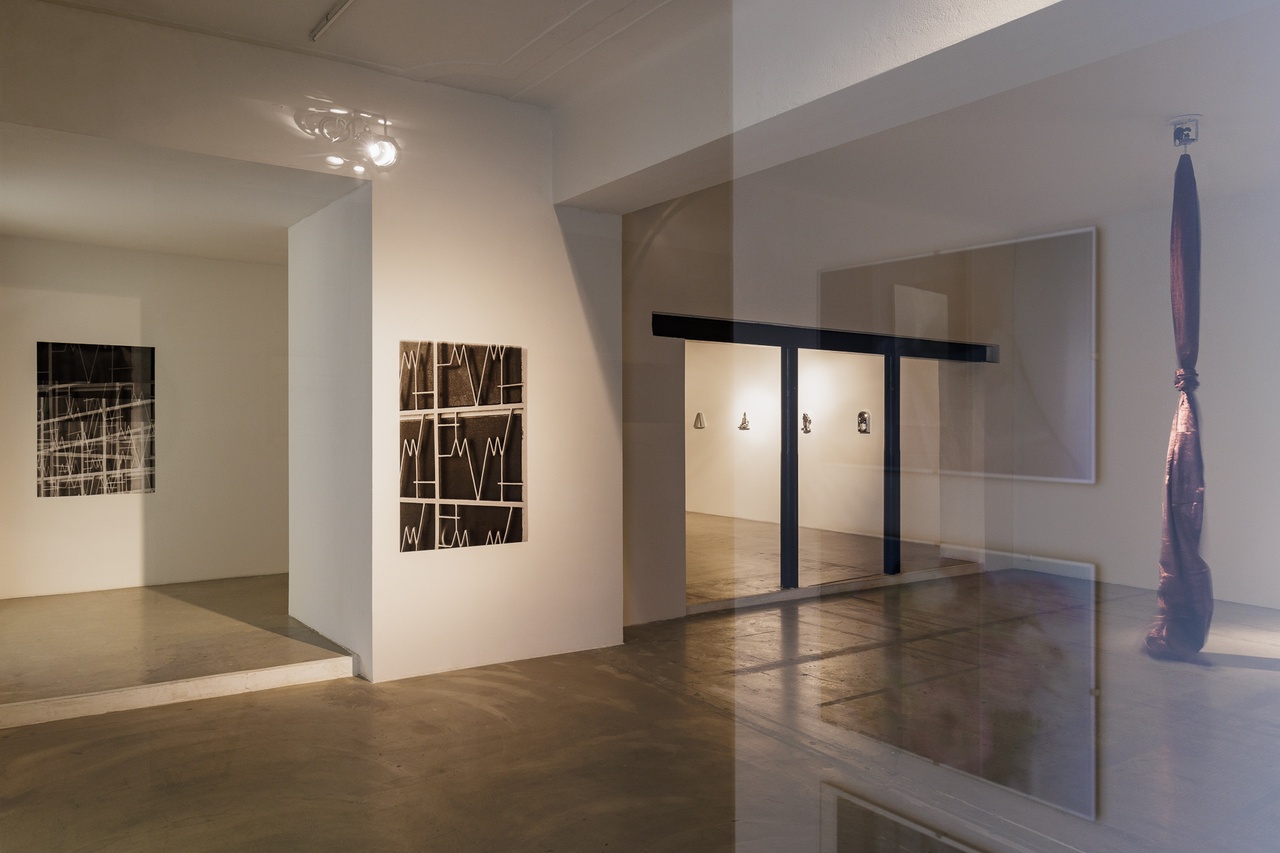THE SONG OF THE BELLS Emile Rubino on Maria Toumazou at Grazer Kunstverein

“Maria Toumazou: RHYTHM, CITIZEN,” Grazer Kunstverein, 2022, installation view
Maria Toumazou’s first institutional solo exhibition, “RHYTHM, CITIZEN,” begins with the faint clicking noise produced by the bellows pumps the artist borrowed from Photo Net, her local photography store in Nicosia, Cyprus. Solemnly placed on a narrow stainless steel plinth in the center of the foyer at Grazer Kunstverein, the set of pumps establishes a pulse that persists throughout the exhibition. Detached from the store’s Noritsu minilab, the delicate mechanism designed to dispense developer and other chemicals through the photofinishing machines’ arteries looks like an organ without a body. The odd kinetic contraption also evokes the mechanical ventilators that hospitals sought out during shortages at the height of the Covid pandemic. In drawing out the inner workings of analogue picture-making, the slow cadence of the pumps in Toumazou’s Developing (2022) elicits elusive images. They appear by corporealizing the visual with the assistance of a “beat or pulse” akin to the one identified by Rosalind Krauss in The Im/Pulse to See (1988) as something that “is not understood to be structurally distinct from vision but to be at work from deep inside it.” [1]
Entrance to offices (2022), a glass door salvaged by the artist from a closed-down business in Cyprus, separates the bright entrance hall from the theatrically lit spaces where the rest of the exhibition unfolds. Affixed to the existing entryway, the repurposed door is shorter, a subtle discrepancy that underscores the process of transplanting it from one location to another. The accretion of dirt on the surface of the glass forms a photogram-like imprint – the result of the door’s previous exposure to the elements, which brings to mind the Dust Breeding (1920), on Marcel Duchamp’s The Large Glass (1915–1923), as photographed by Man Ray. Though the door handle and the old vinyl lettering advise visitors to push, the door slides open automatically to reveal the vaulted ceiling of the dark room behind it. Mediating the flow of light and visitors like the shutter of a camera, the automatized door turns the exhibition space into a proto-photographic environment. Toumazou’s literal take on the assisted readymade is equally photographic – the manual door gets mechanical assistance in a procedure where the surface of the object remains unaltered, while its directionality is revised by a device that frames it and withdraws it from touch.

“Maria Toumazou: RHYTHM, CITIZEN,” Grazer Kunstverein, 2022, installation view
On the other side of the door, the following room is configured as a chapel. This transition from the lobby to the chapel happens to mimic the dichotomy laid out by Siegfried Kracauer in his essay “The Hotel Lobby” (1922). For Kracauer, the communal space of the lobby is an inverted image of places of worship – “in both places people appear as guests.” [2] The three arched windows facing the street are blocked by stained plywood walls, within which found photo filters of different colors have been sporadically inserted to create square peepholes. Stage lights installed in the recessed space between the windows and the provisional walls shine through the filters to produce transilluminations. Similar to stained glass, these filters are reminiscent of the colored squares that make up Gerhard Richter’s window in the Cologne Cathedral. Like defused pixels, Toumazou’s artful illuminations shape the space as a latent image organized around the skeletal structure of an aluminum bed frame. Designed by Toumazou’s friend Felix Taylor for Platten Haus, Taylor’s furniture and homewares business, Banister Bed prototype (2022) is one of the many instances where the artist invited collaborators from her community to contribute to her exhibition. In the context of the chapel, the bed “floods the habitual containment of the public-private binary.” [3]
The drawers underneath the bed and its smooth oak banister serve as a platform to host the work of three Cypriot photographers: Marietta Mavrokordatou, Claudia Paschalides, and Kyriakos Kyriakides. Toumazou commissioned them to source images from their respective archives and contribute three photo essays, which are presented in found office binders. Visitors are invited to open the drawers and look through the photo albums using small flashlights. From lyrical documentary to intimate pictures, each album focuses on a particular individual, giving the viewer a voyeuristic glimpse into the life of someone else’s friend, neighbor or lover.
To complete the bigger picture conjured in this room, Toumazou placed three bronze church bells on the floor. Each one of these shiny nickel-plated bells was paired with a different tongue, each of which cast from items found in the inventory of the foundry that produces bells for most of the churches in Cyprus, as well as insignias and emblems for public authorities. One of the tongues is made from three police badges joined together; another consists of a set of ceremonial keys to the city. The suggestive silence of these modified bells encapsulates the hierarchical distribution of time in the polis enforced by dominant structures. A certain realism defines Toumazou’s sculptural work, whereby meaning emerges from the object itself as much as it stems from the context, external labor, and businesses involved in the production process.

“Maria Toumazou: RHYTHM, CITIZEN,” Grazer Kunstverein, 2022, installation view
Reflecting the multifaceted and porous terms of Toumazou’s engagement as an artist who is also an independent publisher, a retailer of postmodern furniture, and – up until recently – the co-organizer of the art collective Neoterismoi Toumazou, this solo exhibition becomes a tool for conviviality, thereby exemplifying what Ivan Illich would describe as “individual freedom realized in personal interdependence.” [4] By making space for her peers, like Tasos Lamnisos (x.ypno) and Stelios Ilchuk, whose haunting beats and lyrics marked the culmination of the opening weekend with a live performance of their rap album ΕΞΩΣΤ (EXHAUST, 2021), Toumazou expands the boundaries of the exhibition. The localism that grounds her practice imbues her work with both specificity and capaciousness.
The third part of the exhibition is introduced by an antechamber fitted with another sliding door that creates a space where Toumazou presents the work of her studio neighbor Koula Savvidou. In Borrowed time (2008–2009), a series of color photographs printed on rice paper and displayed in modest clip frames, Savvidou documents the hospital bedroom where she tended to her husband for two years. Focusing on flower bouquets, bed sheets and vacant armchairs, these subdued photographs imitate the fuzzy texture of watercolor. They speak to the suspended time of care work, the lonely hours spent “waiting while the potential for panic and pain hangs around.” [5] In these photographs, as in an earlier text from 1995 translated anew by Toumazou and curator Tom Engels for the publication accompanying the exhibition, Savvidou eloquently surveys “the solitude of people committed to saving all that needs to REMAIN!” [6]
Moving past the second sliding door, two large black-and-white photographs of a steel gate whose 1950s design evokes an electrocardiogram pattern echo the work encountered in the lobby. The double exposure in one of the photographs visually activates the pattern of the gate, as if the heart rate was suddenly increasing in what could be described as a photographic tachycardia. These two pictures are part of a larger series of photographs taken by Toumazou on her daily walks through Nicosia. Reproduced in the publication, these images of seemingly trivial architectural details such as tiles or railings act as visual footnotes that add a layer of psychogeography to the exhibition by revealing Toumazou’s subjective experience of her local urban environment.

“Maria Toumazou: RHYTHM, CITIZEN,” Grazer Kunstverein, 2022, installation view
Mounted on a makeshift motor, the kinetic sculpture that occupies the rest of the room consists of a gleaming bronze curtain fabric that hangs from the ceiling and gracefully swirls on the floor. More than the other kinetic elements in the exhibition, the function of this work is primarily choreographic; its hypnotic tempo tests the notion of objective time while throwing off the linear arrangement of the space. “If you keep thinking there is only an ahead and a behind, you are missing the side-to-side which gives evidence to the lie that you are moving progressively. If everything is moving at the same time, nothing is moving at all.” [7] writes Fanny Howe in Night Philosophy (2020). Throughout the space, the simultaneous movement of Toumazou’s lo-fi kinetic arrangements and the side-to-side movement of the doors dramatizes time into a temporal sequence that makes the exhibition feel like an inhabitable picture. As proposed by David Joselit in his essay “Citizen Cursor” (2009), the “suggestion that pictures may become places” [8] is a way for images to be re-situated as communal.
Time is most obviously crystallized in the nine clocks presented in the last room. The simple idea of hanging these nickel-plated bronze table clocks on the wall results in a gravity defying awkwardness that amusingly literalizes the notion of suspended time when the continuum of history comes to halt. Prior to casting the clocks in bronze, Toumazou removed the mechanisms, as if to stop the day and allow the fiction of progress to be “re-regarded, touched and felt.” [9] Manufactured in the 1980s by two Japanese brands, Rhythm and Citizen, the clocks are turned into hyperbolic artifacts that imprison the time of the everyday. Not unlike the bells and the photographic elements that punctuate the exhibition, they suggest that “emancipation is, in the first instance, a recapture of time.” [10] Through her subtle upcycling strategies, Toumazou feels the pulse of material histories, which allows her to rethink the reality of time and point toward the liberating potential of a common time – the resource that all forms of care are predicated upon.
“Maria Toumazou: RHYTHM, CITIZEN,” Grazer Kunstverein, September 24–December 23, 2022.
Emile is an artist and writer based in Brussels. He is the co-editor of Le Chauffage, an artist-run publication based in Brussels and Vancouver.
Image credit: Courtesy of the artist and Grazer Kunstverein, photos kunst-dokumentation.com
Notes
| [1] | Rosalind Krauss, “The Im/Pulse to See,” in Vision and Visuality, ed. Hal Foster, Discussions on Contemporary Culture 2, Dia Art Foundation (Seattle: Bay Press, 1988), 63. |
| [2] | Siegfried Kracauer, “The Hotel Lobby,” in The Mass Ornament (Cambridge, MA: Harvard University Press, 1995), 175. |
| [3] | Lisa Robertson, Thresholds: A Prosody of Citizenship (London: Book Works / Glasgow:The Common Guild, 2018), 5. |
| [4] | Ivan Illich, Tools for Conviviality (London: Marion Boyars, 2009), 11. |
| [5] | Anne Boyer, The Undying (New York: Farrar, Straus and Giroux, 2019), 70. |
| [6] | Koula Savvidou, “On The Solitary Crossing of Impassable Passages,” in R,C, ed. Tom Engels (Graz: Grazer Kunstverein, 2022), 8. |
| [7] | Fanny Howe, “Catholic,” in Night Philosophy (Brussels: Divided Publishing, 2020), 39. |
| [8] | David Joselit, “Citizen Cursor,” in Communities of Sense, Rethinking Aesthetics and Politics, ed. Beth Hinderliter, William Kaizen, Vered Maimon, Jaleh Mansoor, and Seth McCormick (Durham, NC: Duke University Press, 2009), 164. |
| [9] | Fionn Meade, “Time Again” in Time Again (Long Island City, NY: Sculpture Center, 2011), 6. |
| [10] | Jacques Rancière, “Time, Narrative, Politics” in Modern Times: Temporality in Art and Politics, trans. Gregory Elliott (New York: Verso, 2022) 19. |
